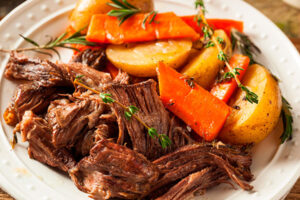What is the Most Tender Roast for Pot Roast?
The best choices of beef are chuck roasts, top round, or brisket. Based on fat content and cost per pound, I choose them in the order listed. Using brisket may make an impression on your audience, but they will likely not be able to discern if you used a less expensive cut of beef like chuck or round. The whole intent of pot roast is to cook it low and slow to break down these cheaper cuts of meat. Spending the extra money on more expensive may not give you the best bang for your buck.
What is the Cooking Time for a Pot Roast?
Depending on size and cut of beef, most roasts will need 3-4 hours for pot roast in oven to become fork tender. If you do not have quality meat thermometer, I would highly suggest that you invest in one. It is the easiest way to determine when meats are cooked. In general, and internal temperature of 200-205 degrees F is regarded as being fork tender. This “rule” works for pork roasts, pot roasts, and even ribs. Once this temperature is reached, the collagen in the meat should be broken down enough to guarantee mouth watering tenderness!
How do I Make my Pot Roast Tender?
The key to making any perfect pot roast in the oven is to braise it.
Braising is a combination-cooking method that uses both wet and dry heats: typically, the food is first browned at a high temperature, then simmered in a covered pot in cooking liquid (such as wine, broth, coconut milk or beer). It is similar to stewing, but braising is done with less liquid and usually used for larger cuts of meat. Braising of meat is often referred to as pot roasting, though some authors make a distinction between the two methods, based on whether additional liquid is added. Osso buco and coq au vin are well known braised meat dishes, and the technique can also be used to prepare fish, tempe, tofu, or fruits and vegetables.
Courtesy of Wikipedia
By braising it slowly, over a relatively low heat, you will guarantee to break down the collagen in the roast. It is this collagen that helps a protein keep it’s shape, as well as it’s inherent toughness. As mentioned earlier, to collagen will typically break down somewhere around to 205 degree F mark. Once it reaches this point, it should shred or pull apart with minimal hand pressure. If you find some resistance, simply continue to cook it while checking after every 10-15 minutes for tenderness.
What Makes a Better Pot Roast?
When combined with the cooking techniques above, nothing makes a better pot roast than serving it with a succulent gravy! By using a braising technique, the gravy will already include the natural beef flavor from your pot roast. But to make the best gravy for pot roast, you need to enhance this natural flavor. Here is how I prefer to accomplish just that:
- Red Wine: Wine pairs excellently with any cut of beef, particularly red wines. In selecting a wine, avoid sweet reds. Stick with stick with Bordeaux or Cabernet Sauvignon for this recipe, or something of a similar flavor. Please under ANY circumstance do not use cooking wine. The most basic rule of cooking with wine is that if you wouldn’t drink it, why would you want it in your food? And quite honestly, there are many budget friendly drinking that are available for just a few dollars more than that nasty bottle of cooking wine. There is no need to go overboard however; an expensive bottle of wine likely won’t give you any benefits. Any wine in the $7-10 dollar range will do just fine when cooking pot roast.
- Beef Stock: This may seem self explanatory, but beef stock is a must have ingredient. The secret is to use a quality stock. Ideally you have some homemade stock lying around, but this is not practical for most of us. The closest thing I have found is to use beef flavored Better Than Boullion. It may seem expensive at first glance, but you get almost 40 cups of broth out of a single $7 jar. I may use boxed or canned stock in a pinch, but I definitely avoid boullion cubes. While they are inexpensive, they have probably been in your pantry for 10 years. All spices, including boullion cubes, lose flavor over time.
- Umami Flavor: Umami is a fancy word that essentially refers to a savory ingredient. Examples include soy sauce, Worcestershire, and my favorite: porcini mushrooms. The type is use is dried porcini sold in my local produce store. They are earthy and last a long time. You only need a small amount, so a small package can go a long way. I break off a small piece and grind it into a fine powder until I get the amount I need for the dish. I not only using porcini when making pot roast, but pretty much any beef based broth, au jus, or gravy.
What to Serve with Pot Roast?
Much like my Beef Tips and Gravy recipe, I prefer to serve the with my best mashed potatoes recipe. I recognize that most traditional recipes suggest that you cook the potatoes with the roast. However I can never resist the urge to make mashed potatoes! I will not judge your choice, but I just simply prefer them over braised potatoes.
I hope this helps answer some of your questions and invite you to give this recipe a shot! If you’ve made this dish feel free to leave a comment below.
Thanks for reading and enjoy!



